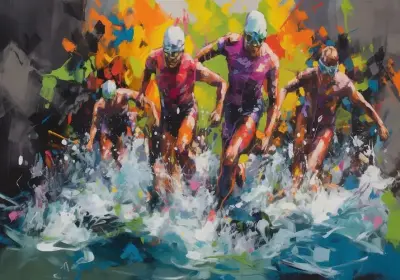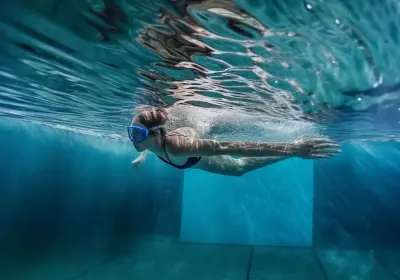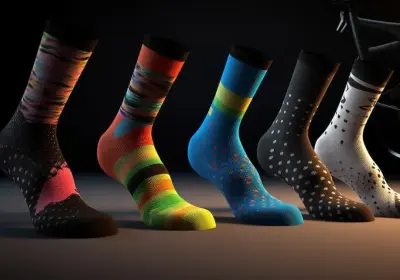Understand the card system in triathlon.

- 1. An Overview of the Card System in Triathlon
- 2. The Essential Components of the Card System
- 3. How the Card System Influences a Triathlon Event
- 4. Diving Deeper into the Rules: Examples and Scenarios
- - Understanding the Consequent Actions and Penalties
- - Case Studies Illustrating the Application of the Card System
- 5. The Role of Officials in Managing the Card System
- - Training of Officials: Ensuring Fairness and Consistency
- - Challenges and Solutions in Real-time Implementation.
- 6. Future of the Card System in Triathlon.
1. An Overview of the Card System in Triathlon
The triathlon card system – an enigma for beginners, a guiding force for seasoned competitors. Knowing your green from your red can make or break your event. At its core, the system is designed to maintain order and preserve the sport's integrity. A committed athlete respects this system, for it mirrors their respect for the sport. Rife with nuances, the card system is an intricate tapestry woven into the adrenaline-heavy tapestry of a triathlon event. It all boils down to the rules of the game – the green, yellow, and red cards acting as silent arbiters, vestiges of discipline in a sport that pushes its participants to their very limits.
- Understanding the Concept and Purpose
Understanding the concept and purpose of the card system in a Triathlon race is integral in appreciating its significance in this sporting event. Simplistically put, the card system is a tool employed by race officials to maintain fair play during the entire race. It is a disciplinary strategy designed to keep athletes in check, ensuring that they follow the rules meticulously. Like traffic lights, the card system operates with green, yellow, and red cards—each signifying a different level of rule violation. Learning about this system allows athletes to understand the standards set in the race, thereby encouraging them to exercise caution and precision throughout. Not only does it serve as a warning system, it underscores accountability and fairness in the competition. So, it’s not just about the fastest swimmer, cyclist, or runner, but rather about the one who can compete while adhering to the stipulated rules and protocols. Consequently, the card system's purpose extends beyond the prevention of rule violations; it promotes integrity and orderliness in Triathlon. It's not a mere punitive measure, but a crucial pillar on which the sport’s credibility and appeal hinge.
- Importance of the Card System in Keeping Order
Understanding the importance of the card system in maintaining order in a triathlon is fundamental for both athletes and officials. The card system is not just a set of rules, it's a crucial tool designed to ensure fair play and prevent chaos in the high-intensity environment of a triathlon. The presence of a structured system places all participants on a level playing field, allowing them to compete with predictability and transparency. It helps to maintain discipline among the athletes and encourages sportsmanship, an essential aspect in any competitive sport. Moreover, it provides guidelines for officials, marking out clear consequences for every possible infraction and helping to remove bias or subjectivity from their decisions. In a nutshell, the card system is what keeps the wheels of a triathlon event turning smoothly, making it integral to the fair and successful completion of a race. Can you imagine the mayhem if there was no structure or rules in place? Picture a triathlon where athletes are unsure of what they can and cannot do - it would result in confusion at best and chaos at worst. The card system provides this necessary structure and indeed, helps keep the order.
2. The Essential Components of the Card System
The beauty of the card system in triathlons lies in its simplicity-yet, its effect can significantly shape the course of the event. Central to this mechanism's effectiveness is the seamless interplay of its key elements: green, yellow, and red cards. Each color carries a unique connotation, not unlike traffic lights. A green card provides a clean slate to the athlete, signifying faultless performance. In contrast, a yellow card serves as a warning shot, alerting the athlete of minor transgressions that need rectifying. However, a red card resonates with immediate disqualification due to significant rule violations. Understanding these components forms the cornerstone for both athletes and officials, promoting fair play and ensuring the smooth conduct of the race. Stay tuned as we delve deeper into how these colors shape the triathlon's dynamics.
- Key Elements and Their Roles
The card system in Triathlon harks back to its innate constituents, also known as its key elements, which extend to cards of various colors: green, yellow, and red – each playing pivotal roles. Displayed by officials to competitors during the event, they are integral in maintaining order and discipline, thereby cultivating a level platform for all athletes. Now, let's dissect the roles that each of these holds. Handing out a Green Card to an athlete constitutes a warning; it’s the official’s way of signaling that they are on notice for a potential rule violation. This lends players a chance to correct their actions and stay on the right side of regulations. The Yellow Card, however, ups the ante. It implies a time penalty due to a rule violation, pushing athletes to rethink strategies, methods, and overall gameplay. Lastly, the dreaded Red Card signifies a serious violation that prompts immediate disqualification. A symbol of absolute non-negotiable respect for the rules, it reinforces the necessity for exemplary conduct throughout the intense competition. Hence, understanding the vital roles each card executes is paramount for both athletes - to refine their strategies for a fair play, and officials - to uphold invaluable fairness and decorum of the Triathlon.
- The Dynamics of Green, Yellow, and Red Cards
In the exhilarating world of triathlon, the card system holds paramount importance, providing transparency and tightly knitted control over the proceedings. Central to this system are the **Green**, **Yellow**, and **Red cards**. These color-coded cards represent a unique disciplinary system in place to ensure fairness and uphold the spirit of the sport. To start, the **Green card** is the least severe among the three. It generally signifies a violation of minor nature - a misspent action that might not necessarily hurt the competition's integrity. However, getting green carded can still amount to time penalties, nudging the triathletes to stay vigilant. Moving on, a **Yellow card** suggests a middling offense. It carries a more significant time penalty and is indicative of larger rules infringements. Consistently accumulating yellow cards might lead to more penalties, duly escalating the degree of scrutiny on the triathlete. Lastly, the **Red card** sounds the alarm bells. This indicates a severe breach of rules or repeated transgressions and can result in disqualifications. Triathletes dread the sight of a red card, for it not only impairs their current standing but might also shadow their future races. Together, the dynamics of these three cards enable the triathlon's smooth execution, injecting a sense of discipline and fair play, reminding each triathlete they're operating within a framework- a beautifully constructed sporting ecosystem.
3. How the Card System Influences a Triathlon Event
The card system plays a pivotal role in shaping the course of any triathlon event. It has a profound influence on the athletes' strategy and overall performance. The green, yellow, and red cards dictate the gameplay, requiring participants to tread carefully, factoring in their every move. Adhering to the rules becomes an integral part of their strategy. They need to be swift, yet cautious; aggressive, yet orderly. The system also encompasses disciplinary actions - a potent deterrent, discouraging foul play, and promoting fair competition. Thus, the card system's impact is far-reaching, stretching beyond being a mere set of rules. It defines the game's rhythm and sets the tone for sporting ethos.
- Impact on Athletes' Performance and Strategy
In any high-end competitive sport like a Triathlon, where endurance, speed and strategy play a pivotal role, the card system has a significant impact on an athlete's performance and strategy. When an athlete is aware of the card system's nuances, they can effectively integrate their knowledge into their game plan. The athletes can optimize their strategy, knowing fully well what actions could lead to a green, yellow, or red card, thus avoiding potential disqualification or penalties. Most importantly, the card system encourages fair play and keeps the athletes within the boundaries of sportsmanlike behavior. This, too, factors into an athlete's overall approach, with many strategically planning their race with respect to their competitors and officials. After all, no athlete would want to receive a card for avoidable or needless aggressive behavior. Moreover, with green cards holding the potential of providing warnings instead of immediate penalties, athletes may take calculated risks, possibly enhancing their chances of a podium finish. The dynamic system allows a smarter, wiser athlete to possibly take advantage of certain situations without blatantly breaking the rules. As a result, understanding the card system is essential for an athlete's performance, offering them the strategic edge needed to excel in such a high-stakes, competitive event.
- Disciplinary Measures and the Card System
The disciplinary measures forming a crucial part of the card system in triathlons cannot be underestimated. This is because the card system directly influences the athletes' approach towards the race and, consequently, the overall event. A green, yellow, or red card can mean the difference between victory and disqualification. This powerful deterrent shapes the competition, ensuring a fair playing field for all participants. Disciplinary actions in the form of yellow and red cards serve to enforce the rules of conduct rigorously, ensuring that no participant gains undue advantage. A yellow card as a warning lets an athlete know that their actions are bordering on the unacceptable, prompting them to rethink their strategy. The red card, however, is a game-changer. It implies a serious violation that can lead to immediate disqualification, thus holding athletes accountable for their decisions and actions in the race. But the card system is not just about penalties; it exists to uphold respect for the sport and fellow competitors. The athletes are encouraged to strive within the rules, making the competition as much about integrity as about endurance, strength, and speed. Quite a fascinating aspect of a triathlon, wouldn't you agree? The card system indeed brings a unique dimension, adding another layer of strategic complexity into this already challenging sporting event.
4. Diving Deeper into the Rules: Examples and Scenarios
To truly appreciate the efficacy and intricacies of the card system in a triathlon, let's delve deep into its application through various examples and scenarios. Imagine an athlete is seen veering off course on their bike; in this instance, they would likely be issued a yellow card, signifying a time penalty. Alternatively, a competitor might show a dubious level of sportsmanship, and is given a red card, leading to disqualification. These situations allow us to grasp the significance of the card system and how it encourages both fair play and strategic thinking among athletes. Without it, the very essence of a triathlon - endurance, skill, and tenacity - could be washed away in the tide of unreined competition.
- Understanding the Consequent Actions and Penalties
One intriguing facet of triathlon is understanding the consequent actions and penalties that come with the card system. While an untimely card could somewhat alter the race's tempo, the resulting consequences and affliction of penalties are all part of the race's essence. A green card implies a minor violation, mostly attracting time penalties that could add crucial seconds to a competitor's finishing time. More serious offences, signified by a yellow card, may see athletes serving prolonged time penalties in the next transition or penalty box. A red card, however, is the most dreaded — it's the ultimate penalty. It doesn't just equate a disqualification, but could also invite sanctions affecting subsequent participation. It's key for participants to not only comprehend these actions, but also to strategize around these possibilities. After all, a race can swing either way when penalties come into play. Thus, understanding the balance and maintaining discipline becomes a part of the competitive strategy, as much as physical endurance and strength do. What do you think? Would knowing the potential penalties change the way you approach a competition? The card system, in this light, isn't merely an enforcement tool; it's an integral part of the strategy and sport itself.
- Case Studies Illustrating the Application of the Card System
The profound influence of the card system in Triathlon is best exemplified through real-life applications. Let's remember the 2008 ITU World Cup in Madrid where a leading athlete was served with a red card for position violation. Despite the athlete's prowess, the penalty had a significant impact on the race results. This event illustrated the critical role the card system plays to level the playing field and promote fairness. In another instance, in a local Triathlon competition, an athlete subtly cut off another during the run, which ordinarily might have gone unnoticed. But keen-eyed officials served a yellow card, resulting in a time penalty envisaged under the rules. Here, again, fair competition was ensured, proving the card system's vitality. It is through these case studies we understand that the card system plays more than a disciplinary role. It shapes athlete strategies, impacts outcomes and ultimately dictates the thrilling narrative of each race. They stand testament to the blend of endurance, rules, and unexpected moments that make Triathlon a riveting sport. These examples depict its effects at both the micro and macro level, underlining the significance of every green, yellow, and red card.
5. The Role of Officials in Managing the Card System
The role of officials in effectively managing the Card System in the sport of Triathlon cannot be overstated. These officials form the backbone of the system, leveraging their training and expertise to uphold standards of fairness and consistency throughout each event. This complex, time-critical role presents unique challenges, including managing diverse athlete tactics, rapidly changing event dynamics, and making split-second yet fair decisions. Such hurdles underline the need for rigorous training and steadfast focus. However, these challenges are not insurmountable, with innovative solutions continually evolving, promising more robust and precise adjudication in future Triathlon events.
- Training of Officials: Ensuring Fairness and Consistency
Training of officials in the triathlon card system is a critical aspect to ensure fairness and consistency during the events. This training requires a holistic understanding of the sports 'ins and outs.' It isn't simply about knowing when to hold up a yellow or red card. It's about comprehending the nuances of the sport, gauging an athlete's performance, and diligently observing every single aspect of the race. The responsibility of maintaining a level playing field is on the shoulders of these officials. Therefore, their training tends to be rigorous and highly detailed. From understanding the various rules to acting promptly in diverse situations, the training program equips them comprehensively. This perhaps may lead one to question - just why is such intensive training essential? Well, it's because our primary aim is to sustain the sport’s sanctity. Admittedly, this task isn't always straightforward. Officials may encounter complex situations that need immediate resolution. However, with an inclusive training regime, they are better prepared for all possible scenarios. And, the stronger their grasp of the system is, the more consistently they can apply those rules, regardless of the athlete or the circumstances. Because in the end, consistency is indeed paramount in a sport where minutes, or even seconds, can alter the outcome drastically. But, can technology play a role in improving this system further? Only time will tell.
- Challenges and Solutions in Real-time Implementation.
Implementing the card system in real-time at triathlon events encounters numerous challenges. One critical issue lies in the subjectivity of officials. The human element introduces natural inconsistency and bias into penalty decisions. Training of officials is paramount to ensure fairness, objectivity, and consistency in the adjudication. A comprehensive program that emphasizes the understanding of rules, athlete behavior, and ethics can help alleviate such issues. Yet, even with the most rigorous training, real-time observation of all athletes in a triathlon can be nearly impossible due to the wide-ranging and dynamic nature of the event. Technology presents a viable solution to this problem. Utilizing advanced systems to track and review athlete performance can aid officials in pinpointing rule infractions, ensuring more accurate rulings. In addition, enhancing communication between officials can promote better consistency in implementation across the event. However, the incorporation of technology is not without its hurdles. Cost, reliability, and resistance to change among officials and athletes are potential roadblocks. Overcoming these challenges requires innovative approaches, adaptive mindsets, and a dedication to maintaining the integrity of triathlon. Ultimately, the solutions for effective real-time implementation of the card system hinge upon the synergy of human expertise and technological advancement.
6. Future of the Card System in Triathlon.
Looking towards the future, the card system in triathlon holds enormous potential for growth and innovation. With technological advancements on the horizon, the card system could become digitized, offering instant updates and more precision in regulating athlete conduct. As technologies like augmented reality and artificial intelligence continue to evolve, they could be integrated to offer real-time insights on rule infringements, ensuring fair competition. This will not only make the process less challenging for officials but also more transparent and efficient. However, it's crucial to anticipate and adapt to these changes proactively. The future of triathlon indeed promises exciting times with its embrace of technology and continuous drive for improvement.
- Technology and the Card System
In the rapidly evolving world of technology, the card system in triathlon is not left untapped. With technology at the helm, the administration of triathlons is witnessing essential improvements. Triathlon events, renowned for their unwavering demand for precision and fairness, are now starting to rely more on digital solutions to manage the card system accurately and efficiently. Hi-tech solutions are now being employed to keep the administration of the card system seamless and fair to all athletes. One significant development is the use of mobile applications to manage the handout and tracking of cards during the competition. These applications provide instant information to officials, athletes and even spectators, adding transparency to the process. Instant replay technologies are also proving essential in reviewing controversial incidents and deliberating on the appropriate card to award. The use of drones for aerial supervision is another frontier being explored. These high-tech devices provide a comprehensive view of the field, making it easier to spot infractions that field officials might miss. With these technological innovations, the card system in triathlon is evolving swiftly with the promise of higher efficiency and fairness in the sport. The future is indeed an exciting prospect, and embracing these emerging technologies signifies a step forward for a fairer and more exciting triathlon experience.
- Anticipating Changes and Future Perspectives.
Anticipating Changes and Future Perspectives in the card system in a triathlon is proving to be an exciting and thought-provoking endeavor. As technology continues to evolve, it invariably influences all facets of life, including sports. We foresee the possibility of automation and digitization playing a pivotal role in this aspect. Imagine a future where RFID chips or smart wearable devices are used not just for time tracking, but also for identifying rule violations in real-time. These could potentially simplify the work of officials and reduce human error. Moreover, innovations like AI and machine learning can provide an in-depth analysis of an athlete's performance. It can identify patterns or tactics that can heighten the risk of violations. Understanding these patterns can lead to proactive, preventive actions, thereby reducing yellow and red card scenarios. One must also consider that with these technological advances, new challenges inevitably arise. While technology can streamline processes, equitable accessibility and data privacy are serious concerns that need addressing. Given these considerations, it's necessary to continuously revisit and revise the rules of the game, ensuring they adapt to new realities while keeping the spirit of the sport alive. So, while speculating future trends, remember that the core aim is always to encourage fair play and uphold the integrity of triathlon.
In conclusion, a clear understanding of the card system in triathlon is essential for athletes, officials, and spectators alike. This system ensures fairness, influences performance strategy and provides a method of discipline. However, as technology evolves, so may the system, introducing potential future alterations. For now, further comprehension of this system and the professional development of officials can ensure truth and consistency in triathlon events.
What is the Card System in a Triathlon?
The card system in triathlon is a disciplinary method used by officials to maintain order and sportsmanlike behavior during the event.
What are the Key Components of the Card System in a Triathlon?
The key components of the Card System are the Green, Yellow, and Red cards, each carrying different implications for the penalized athlete.
How Does the Card System Impact a Triathlon Event?
In the context of a triathlon, the card system directly influences athletes' performances and strategies, as well as disciplinary measures.
What Role does an Official play in a Triathlon's Card System?
Officials play a crucial role in the implementation and management of the card system, and their training is focused on ensuring consistency and fairness.
How is the Future of Card System in Triathlon Anticipated?
Future developments in the card system may include technological advancements for better real-time implementation. The card system is expected to undergo changes in the future, influenced by athletes' feedback, technological innovations and evolving sport regulations.


















































Leave a comment